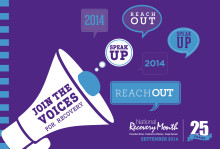 This month marks the 25th year of what has evolved into National Recovery Month. With an early focus on the slogan “Treatment Works,” the event took on its recovery focus in 1998 just as new and renewed grassroots recovery community organizations (RCOs) were rising across the U.S.
This month marks the 25th year of what has evolved into National Recovery Month. With an early focus on the slogan “Treatment Works,” the event took on its recovery focus in 1998 just as new and renewed grassroots recovery community organizations (RCOs) were rising across the U.S.
RCO representatives came together at the 2001 Recovery Summit in St Paul, MN to launch the formal organization of a new recovery advocacy movement under the leadership of Faces and Voices of Recovery.
In the intervening years, Recovery Month celebration events have grown beyond what anyone could have predicted. Local recovery celebration events that once welcomed a few dozen brave participants grew into the hundreds and then into the thousands.
This month, in community after community, recovering people and their families and allies will fill parks and streets as far as the eyes can see – an ocean of lives touched and transformed by recovery. More than 450 recovery celebration events are scheduled this month in the U.S. and such events will also transpire around the world – from Vancouver to Cape Town, from Tokyo to London.
I never expected to live to see a day when hundreds of thousands of people in recovery representing diverse pathways of recovery would be marching publicly as “people in recovery” under a single banner: “There are multiple pathways of addiction recovery and ALL are cause for celebration!”
My earliest professional involvement with the treatment of addiction was in the late 1960s. Working as a “psych tech” at a state mental health facility and then in a role mixing “streetwork” (indigenous outreach in today’s vernacular), crisis intervention, and addiction services development, I had the opportunity to witness the state of the world prior to the emergence of a national network of addiction treatment and recovery support programs.
My memories from those days are still quite vivid. Those addicted to alcohol and other drugs languished in the “drunk tanks” of local jails and in despair-filled prisons and in the “back wards” of aging state psychiatric hospitals – the overcrowded rooms and hallways of the latter permeated with the smells of paraldehyde, sweat and urine.
Medical charts of addicted patients revealed earlier “treatments” that included coerced sterilization procedures, indiscriminate chemo- and electroconvulsive therapy, prefrontal lobotomies, and every manner of psychiatric medications, including LSD, amphetamines, sedatives, and tranquilizers.
I recall a world in which “morality clauses” in community hospital bylaws prohibited admission of addicted persons and a world in which most communities had no specialized recovery support resources outside the meeting rooms of AA and NA.
No detox. No inpatient or outpatient programs. No addiction medicine or addiction counseling specialists. No employee assistance or student assistance programs. No primary prevention programs. No one stepping forward to challenge the degrading public stereotypes attached to addiction–and definitely no one stepping forward to put a public face on addiction recovery.
So as we mark the 25th anniversary of Recovery Month, it is quite fitting to recall why public education and policy advocacy is so important.
Today, people all over the country are living lives of restored health and community service who, half a century ago, would have died or been subjected to prolonged, dehumanizing institutionalization. What has happened instead in their lives and to their families and communities is what Recovery Month is all about.
To all those people in the professional and volunteer community who helped create the world where this is possible, we also honor your years of service during this month of recovery education and celebration.’


